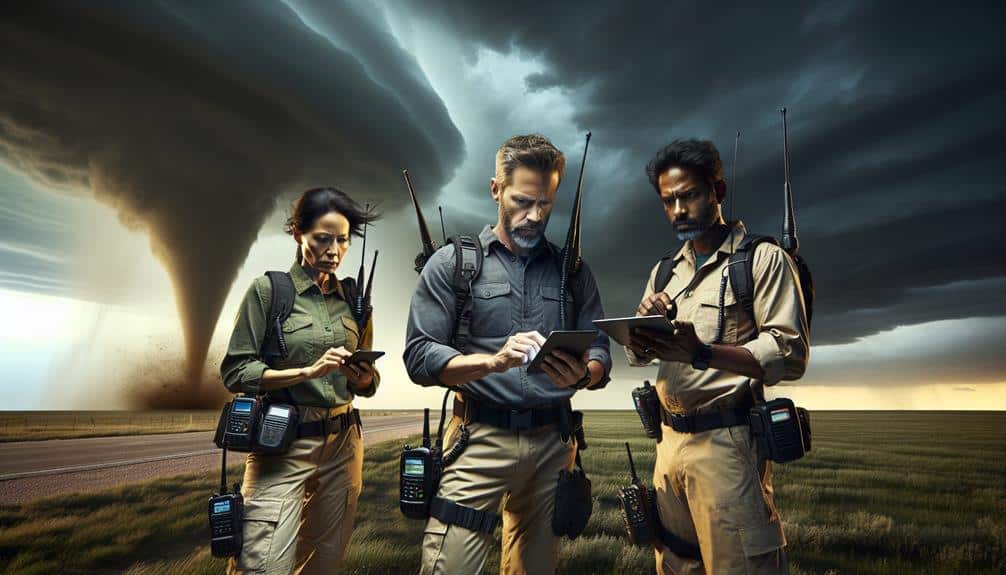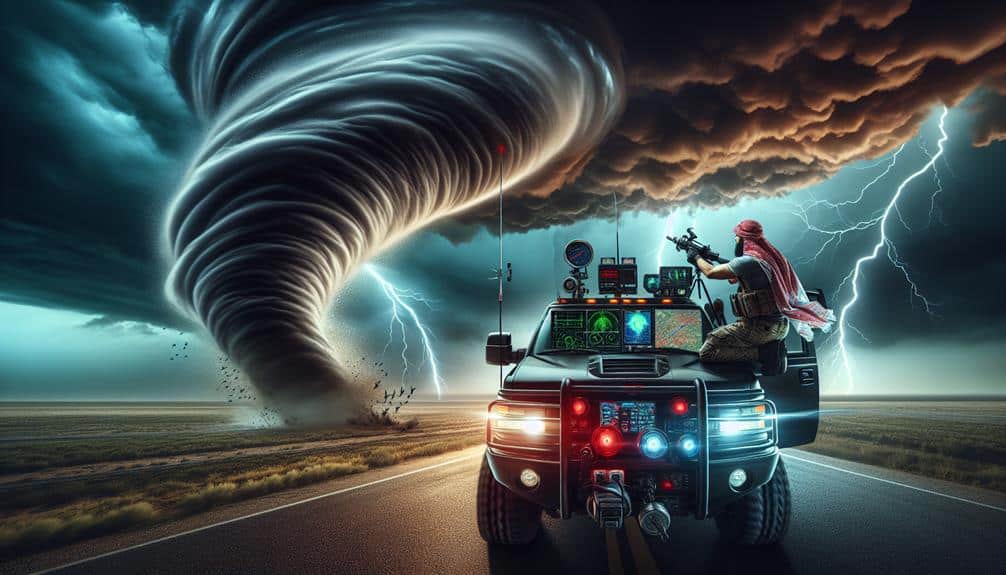We prioritize strong communication strategies during storm chasing by evaluating our specific needs and establishing clear protocols. We select dependable devices with strong network coverage, durability, and redundancy, such as satellite phones and two-way radios. Regular equipment checks and ensuring reliable power sources like portable batteries and solar panels are important. Training every team member for effective, clear communication is necessary, as is the use of standardized language to minimize misunderstandings. By following these seven tips, we can maintain dependable communication and enhance safety in difficult conditions. Next, let's explore the details of each step.
Key Points
- Utilize satellite phones for reliable communication when cell networks fail.
- Implement redundant systems with backup devices to ensure continuous connectivity.
- Conduct regular equipment checks to maintain functionality and prevent breakdowns.
- Train team members in standardized communication protocols for clarity and efficiency.
Assess Communication Needs
We must first evaluate the specific communication requirements necessary for effective storm chasing operations. By evaluating priorities, we determine what's crucial for our missions. Real-time data exchange, clear voice communication, and reliable alerts are non-negotiable. Our communication plans must be robust, making sure every member remains informed and connected despite adverse conditions.
We start by identifying the primary channels needed. Mobile networks, radio frequencies, and satellite links each offer unique advantages. A mix of these guarantees redundancy and reliability.
Next, we consider the range and clarity of our communication tools. Storm chasing often means venturing into remote areas where signal strength can be unpredictable. Therefore, our equipment must operate efficiently under such constraints.
Additionally, our communication plans should include predefined protocols for emergency situations. This involves setting up specific codes or signals to indicate danger or the need for immediate assistance. We must also establish regular check-ins to monitor everyone's status, especially when visibility is low, and conditions are changing rapidly.
Evaluating these priorities allows us to create a thorough communication strategy that enhances our ability to chase storms effectively while maintaining our freedom to explore and document these natural phenomena.
Choose Reliable Devices
Selecting the right devices is crucial for maintaining dependable communication during storm chasing operations. We must consider various device options that provide strong performance and reliability under extreme conditions. A thorough analysis of these options allows us to sustain effective communication in the face of unpredictable weather.
First, we need to evaluate the network coverage of each device. It's crucial to choose devices that can connect to multiple networks, sustaining we stay connected even in remote areas. Additionally, devices with enhanced signal strength can make a significant difference in sustaining communication lines.
Consider these critical aspects when choosing devices:
- Durability: Devices should withstand harsh weather conditions, including heavy rain, strong winds, and dust.
- Battery Life: Our devices must have long-lasting batteries to sustain they remain operational throughout extended storm chasing sessions.
Utilize Satellite Phones
Let's utilize satellite phones to guarantee we maintain a reliable signal anywhere, even in remote locations. These devices allow us to stay in constant communication, vital for safety and coordination.
Additionally, satellite phones provide essential emergency contact capability, which can be life-saving during extreme weather events.
Reliable Signal Anywhere
Satellite phones provide a dependable means of communication, guaranteeing a reliable signal even in the most isolated and storm-impacted regions. When chasing storms, we face numerous challenges that can disrupt standard communication methods. Satellite phones stand out by offering consistent connectivity, regardless of our location or the severity of the weather conditions.
To optimize the performance of our satellite phones, we can implement several strategies:
- Signal boosters: These devices enhance the phone's ability to connect with satellites, especially in remote locations where signal strength might be weaker.
- Antenna positioning: Properly positioning the antenna is essential. We should make sure it has a clear line of sight to the sky, avoiding obstructions that could block the signal.
Emergency Contact Capability
During storm chasing, the ability to make emergency contacts promptly through satellite phones can be an essential lifeline. This capability guarantees we're not solely dependent on terrestrial networks, which are susceptible to failures during severe weather events. Satellite phones provide reliable communication channels, making them indispensable for our emergency plan.
In our communication strategy, integrating satellite phones means we're prepared for the unexpected. They offer a direct connection to emergency services, regardless of our location. Unlike traditional mobile networks, satellite systems cover vast, remote areas, ensuring we can always reach out for help. This is vital when navigating unpredictable storm paths where traditional signals may falter.
Furthermore, the real-time data provided by satellite phones can enhance our situational awareness. We can receive weather updates, coordinate with team members, and report emergencies promptly. This strategic advantage allows us to make informed decisions promptly, maintaining both safety and efficiency.
Implement Redundant Systems
We must implement redundant systems to guarantee communication reliability during storm chasing. By incorporating backup communication devices and utilizing multiple power sources, we can mitigate the risk of single points of failure.
This redundancy enhances our ability to maintain contact under extreme conditions.
Backup Communication Devices
To guarantee seamless communication amid severe weather conditions, it's critical to implement redundant systems by incorporating backup communication devices. When we're out chasing storms, our primary communication channels might fail due to extreme weather. Having multiple devices guarantees we stay connected, which is essential for executing our emergency plans and refining our communication strategies.
Backup communication devices offer a safety net. We must consider:
- Satellite Phones: These remain operational even when traditional cell networks fail, offering a reliable line of communication.
- Two-Way Radios: They're indispensable in short-range communication scenarios, guaranteeing team members can coordinate effectively.
Each device serves a unique purpose in our overall strategy. Satellite phones provide a lifeline when we're out of cell range, while two-way radios are perfect for immediate, localized communication. Mobile hotspots keep us connected to broader networks, essential for data-heavy coordination.
Multiple Power Sources
Securing continuous communication also demands redundant power sources, as our devices are only as reliable as their ability to stay charged during prolonged storm chasing missions. Reliable power management is critical, and having multiple power sources can make the difference between success and failure. By integrating diverse power options—such as portable batteries, vehicle chargers, and solar panels—we enhance our overall emergency preparedness.
First, we should invest in high-capacity portable batteries. These provide essential backup power when traditional sources are unavailable.
Next, vehicle chargers offer a reliable means to recharge devices while on the move. However, we must secure that these chargers are compatible with our devices and capable of handling the power requirements specific to storm chasing technology.
Solar panels serve as a sustainable power source, especially useful when stationary for extended periods. While they depend on sunlight, modern advancements have increased their efficiency, making them a viable option even under variable weather conditions.
Combining these power sources creates a robust, redundant system that mitigates the risk of power failure.
Regular Equipment Checks

Regular equipment checks are crucial for maintaining the reliability of our communication systems during storm chasing. As we navigate unpredictable weather conditions, timely weather updates and seamless communication can make the difference between a successful chase and a hazardous situation.
To ensure top performance, we need to be diligent about equipment maintenance.
Our approach to equipment checks should be systematic and thorough. Here are a few key steps:
- Inspect Antennas and Cables: Regularly examine antennas and cables for any signs of wear or damage. Faulty components can lead to signal loss right when we need it most.
- Test Communication Devices: Routinely test all radios, satellite phones, and other communication devices. Ensuring they're fully operational before heading out can prevent failures in critical moments.
Incorporating these checks into our routine allows us to focus on the chase with confidence. By prioritizing equipment maintenance, we minimize the risk of communication breakdowns, supporting our goal of staying informed and safe amidst the storm.
Train Team Members
Effective storm chasing depends on our team's ability to communicate smoothly, making it crucial that we rigorously train all members in the use of our communication systems. To achieve this, we must focus on thorough communication training programs designed to enhance team unity. By making sure that every team member understands how to operate the communication devices, we minimize the risk of miscommunication during critical moments.
Training should be hands-on and ongoing, integrating real-world scenarios that simulate the dynamic conditions of storm chasing. This approach allows team members to become skilled with the equipment and ensures they respond swiftly and effectively under pressure. Including regular drills and role-playing exercises can further strengthen these skills.
Team cohesion is greatly boosted when everyone is on the same page regarding communication protocols and equipment usage. It's vital to cultivate an environment where team members can freely ask questions and share insights, promoting a culture of continuous improvement. Emphasizing the importance of clear, concise, and accurate communication can greatly enhance our operational efficiency.
Establish Clear Protocols

Establishing clear communication protocols is crucial for coordinating our storm chasing activities effectively. By defining roles and responsibilities, we guarantee that everyone knows their tasks and how to execute them. This streamlined approach allows for efficient communication and smooth operation, even in high-stress situations.
To achieve this, we must:
- Develop clear instructions: Each team member should understand their specific tasks, from navigation to data collection. This clarity fosters an effective response when conditions change rapidly.
- Utilize standardized language: Using common terms and phrases minimizes misunderstandings. This ensures everyone is on the same page and can react quickly and accurately.
Frequently Asked Questions
How Can We Ensure Battery Life During Extended Storm Chasing Expeditions?
Did you know 40% of storm chasers report battery failure? To maximize battery life, we use power banks, solar chargers, and satellite phones. Keeping emergency contacts updated guarantees our safety during extended expeditions.
What Are the Best Practices for Communication During Night-Time Storm Chasing?
During night-time storm chasing, we should use night vision to maintain situational awareness. Signal boosters can enhance our communication range, ensuring we stay connected in remote areas. This approach maximizes safety and operational efficiency.
How Should We Handle Communication if Cellular Networks Go Down?
If cellular networks go down, we should implement our backup plans. Satellite phones provide reliable communication. Establishing these systems guarantees we maintain contact, preserving our freedom to safely navigate and document extreme weather conditions.
What Is the Role of Weather Apps in Storm Chasing Communication?
Weather apps play an essential role in storm chasing communication. They provide data accuracy and real-time updates, helping us make informed decisions. Accurate, timely information empowers us, enhancing safety and effectiveness during our storm chasing endeavors.
How Do We Coordinate With Emergency Services During a Storm?
We coordinate with emergency services by implementing a precise coordination strategy. Our emergency response involves real-time updates, clear communication channels, and collaborative efforts with local agencies to guarantee effective, timely responses during storm events.


